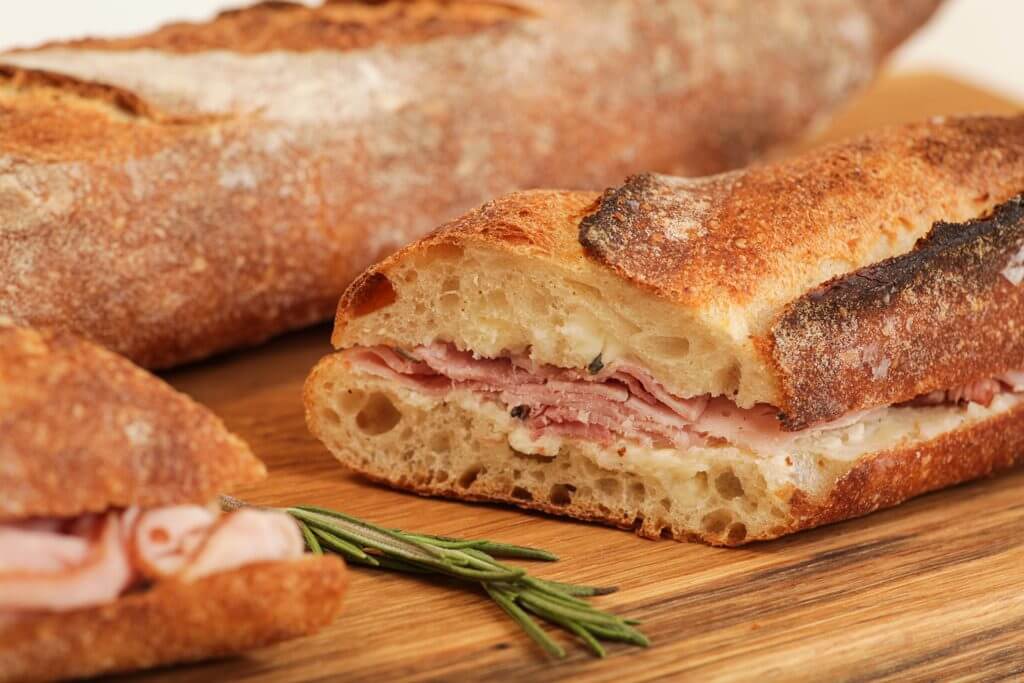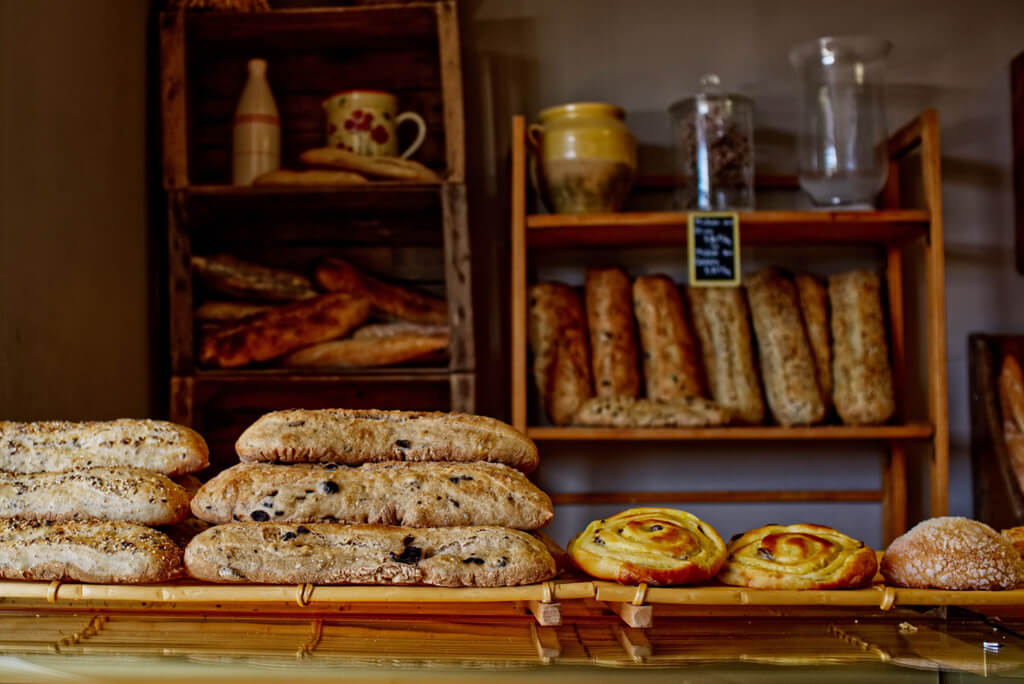The Parisian Baguette – One of the Most Iconic Foods in Paris

If there’s one thing the whole world envies in Paris, it’s its tasty, traditional baguette. The Parisian baguette is one of France’s most iconic foods, a kind of unofficial symbol of Paris. Baguettes are dangerously good too!
In Paris, baguettes are an indispensable part of everyday life. You will find the Parisian baguette in any traditional French breakfast, but also at lunch, dinner, or for a quick eat on the go.
Also, eating baguettes is usually at the top of every traveler’s bucket list when they go to Paris.
So what makes the Parisian baguette so great?
It is all about its lovely caramel color, crusty exterior when it is still warm, and soft crumb interior. And of course the taste!
The French take bread very seriously, and Parisians are no exception to the point that some people are ready to go far to find the perfect Parisian baguette. When somebody moves to a new apartment in Paris, it is common that he spends the first 1-2 weeks touring the boulangeries around home looking for the best Parisian baguette.

Read more about food in Paris
TIP: learn how to make Parisian baguettes with this 2-hour fun cooking class
Le Décret Pain (1993), the French Bread Law
Like many food products in France, the traditional baguette is protected by law. In 1993, the French Government passed the French Bread Law, a rule that establishes how to make the traditional baguette to protect it from other industrial breads.
What are the rules to make a traditional baguette?
According to this decree, the traditional baguette can only be made on-site and with the following ingredients: wheat flour, water, yeast and/or sourdough, and salt.
Three additives are authorized: 2% bean flour, 0.5% soy flour, 0.3% wheat malt flour (these percentages represent the maximum authorized proportions). Note that gluten is not considered an additive.
Parisian Baguette History

Before the baguette, the bread was round, kept for a long time, often made with buckwheat flour, which gave it a darker color.
What is the Parisian baguette history? The origin of the baguette in Paris is uncertain, and there are different theories.
Some historians believe that the French bakers imported the idea of a long bread from Vienna in the 19th century.
Others claim instead that the baguette originated during the French Revolution. On November 15, 1793, a decree of the Convention stipulated that all French people should eat the same bread: Le Pain Égalité.
At birth, the shape of the baguette was not yet clearly defined. It was Napoleon Bonaparte, in 1856, who decided definitively, opting for an elongated shape so that the soldiers can carry them in a pocket at the back of their coat.
What is known for sure is that the baguette became widespread in Paris in the 1920s. It was the Parisian baguette, and it had a hard time being accepted in the countryside where people preferred the darker and round bread which was kept longer.
La Meilleure Baguette de Paris Contest

La Meilleure Baguette de Paris – The Best Baguette in Paris – is a contest organized by the City of Paris since 1994 to choose the best baguette in Paris. It is a fun and, at the same time, tough contest because the bakers need to follow strict rules for making the Parisian baguettes.
The contest takes place in the premises of the Professional Chamber of Artisan Bakers-Patissiers located on Ile-Saint-Louis, and the winner receives a medal, a prize of 4,000 euros, and the honor to become a baguette supplier to the Élysée for a year (plus suddenly, everybody wants to buy his baguettes).
The criteria for choosing the best Parisian baguette are cooking, crumb, taste, smell, and appearance.
A good Parisian baguette should neither be undercooked nor overcooked. It has to be dense and crunchy on the outside and soft and fluffy on the inside (but not chewy).
For this Parisian baguette contest, the baguettes must be between 55 and 65 cm long, weigh between 250 and 300 grams, and have a salt content of 18 grams per kilogram of flour.
This year 2021 you can find the best Parisian baguette in the boulangerie ‘Les boulangers de Reuilly’ by Makram Akrout at 54 Boulevard de Reuilly in Paris 12.
How to Eat a Baguette

In Paris, it is very common to see people eating baguettes on the street. When you send somebody to buy the baguette, rarely, the crouton (the baguette’s pointy end) arrives home!
One of my friends was sent every day to buy the baguette when he was a kid. Her mother actually asked him to buy 2 baguettes since she knew he would eat one on the boulangerie’s walk home.
How to eat a baguette? Purists will tell you that you never cut the baguette. You break it.
For breakfast, it is common to eat the Parisian baguette with jam, or butter. The French verb tartiner means to spread or expand the jam, butter, or cheese on the bread. The result of tartiner is a tartine and it is delicious!

In Paris, baguettes are also used for making sandwiches. Baguette sandwiches are one of the most popular cheap eats in Paris, perfect for eating something-something on the go.
The most famous baguette sandwich is the Parisien – also known as jambon-beurre. Basically, a jambon-beurre is a half baguette sandwich sliced open, spread with butter and some slices of ‘jambon de Paris.’
According to some sources, 2 million jambon-beurre sandwiches are sold every day in France, so don’t underestimate the power of a jambon-beurre!

You can eat a piece of baguette for lunch or dinner, and in many restaurants or Parisian bistros, waiters will bring you a small basket with half a baguette (cut into pieces) even before you order your meal.
You can also eat a piece of baguette with the cheese, after the meal and before the dessert.
Read more about food in Paris
Fun Bread and Baguette Facts
France has the highest density of bakeries in the world, with 32,000. That’s less than 54,000 in 1950.
Bread is such an important part of the French culture that laws up until 2014 prevented all bakers in Paris from taking summer holidays at the same time (typically in August).
The French consume nearly 30 million baguettes of bread daily. However, baguettes are less popular than in 1900, when the average French person ate more than three baguettes every day.
The Paris baguettes are, however, safe from ever dying out. It’s one of the most loved and easily recognizable breads from around the world and everybody wants to eat Parisian baguettes.
Baguette means stick because its long shape.
In Paris, you can also find baguettes magiques (magic baguettes or magic wands). Sold at the Boulangerie – Pâtisserie LeGay Choc (45 rue Sainte-Croix de la Bretonnerie, Paris 4) they cannot be considered traditional baguettes, but they taste good!

Fun French Expressions with Bread

In France, bread is so important that you will find many old expressions around bread. Some of them are still very popular today!
Long comme un jour sans pain – Long like a day without bread
Il n’y a ni pain ni pâte au logis (There is no bread or dough at home) – we need to do the groceries
Il a plus de la moitié de son pain cuit (He has more than half of his bread baked – He’s going to die soon
Il a mangé le pain du roi (He ate the king’s bread) – He went to jail
Bon comme du bon pain (Good as good bread) – a good, non-malicious person
Mieux vaut pain en poche que plume au chapeau (Better bread in pocket than feather in hat)
Gagner son pain (To earn his bread) – to support himself
Faire passer le goût du pain (Pass the taste of bread) – to kill somebody
Ça ne mange pas de pain (It does not eat bread) – do or say something without importance
Retirer le pain de la bouche (Take the bread out of your mouth) – Deprive someone of what they need.
Partir comme des petits pains (Gone like hot cakes) – something easy and quick to sell





